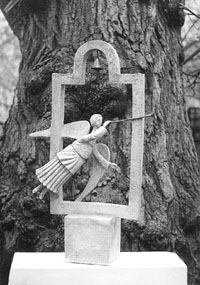“Atlantes and Caryatids”

A new exhibition, Atlantes and Caryatids, has been unveiled at the Kyiv Pecherska Lavra’s Kolory Gallery. It is composed of the works of three ceramists: Nina Skora, Mark Halenko, both of them Kyivans, and Oleksandr Vilchynsky from Zaporizhzhia.
The exhibition allows making, if not interpretations, at least explanations. In any case, the show can be systematized. One possible system is: from ceramics to sculpture. In other words, from Oleksandr Vilchynsky to Nina Skora then to Mark Halenko. Yet, this sequence can also be read in the reverse order, with all logical links remaining intact.
Oleksandr Vilchynski’s ceramics is the continuation of traditions, not only Ukrainian but also worldwide, international, dating back to God knows which unlettered centuries. Hence the deliberate rejection of any eye-catching superficial detail. The Zaporizhzhia-based master’s ceramics is self-sufficient. What distinguishes it is its wonderful, almost porcelain thinness of surface, lightness, its simplicity and perfection of form, and, finally, its overall convenience for everyday life. And now, almost before our eyes, craft is mysteriously transformed into art, with all the looseness and imprecision that these notions imply. It is, of course, impossible to grasp and explain this transformation, but it seems almost materialized in Vilchynsky’s ceramics, when the neck of a vase is a little off its precise geometric center.
Conversely, Nina Skora’s works reveal a clearly ethnic touch. Yet, ceramists usually take the achievements of Ukrainian potters as a point of departure, if not a springboard, in search of their own paths and artistic language. Somehow or other, Nina Skora makes equally bold experiments both with vessels and with small decorative plaques.
Finally, Mark Halenko’s ceramics are in fact sculptures made through ceramics. It can be symbolic, laconic, and all-consuming. It seems, however, to show clear affection, rather than preference, to the subject. One way or another, he is a brilliant storyteller. Some of his sculptures are austere and ascetic, for they are intended to give a stern reminder and their characters are angels and apostles. However, the tone of most ceramic stories becomes entirely different in tone, not content! Indeed, the most serious things happen: Herodotus Discovers a Scythian, and A Scythian Discovers Herodotus. That this occurs in an informal drinking bout by no means diminishes the historically ground-breaking nature of the reciprocal discovery. In the same way, the aerobatics demonstrated by daredevil witches or Tsarina Catherine savoring the golden halushky (kind of ravioli — Ed.) only promote the greatness of Nikolai Gogol to whose works Halenko dedicated a cycle of ceramic plaques.






